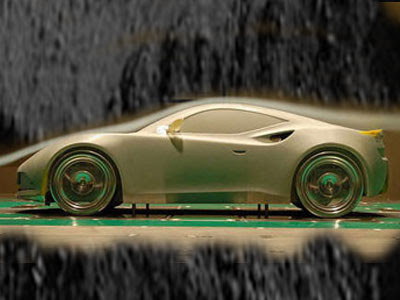Artega GT, 2008




The Design features:
agility, driving dynamics and safety
The major development parameters for the vehicle body were lightweight design and rigidity. A generously dimensioned aluminium space frame in connection with a body made of carbon fibre reinforced compound materials thus ensures a top power-to-weight ratio.
For reasons of efficient space utilisation, ideal weight distribution and the best possible traction, the high-grade drive components of the Volkswagen Group are installed as rear engine traverse to the direction of travel. The 3.6-litre V6 is the ideal drive for a vehicle of this class. Along with the highly praised and well-tried direct-shift gearbox, the engine is mounted in a compact module made of highstrength steel tubes. The backs of the comfortable sports seats fold back to make loading easier. Especially effective crash modules as well as a steel side-collision protection as essential features of the passive safety system protect the passengers with front and side airbags in the case of accident. To ensure a maximum of active safety, the Artega GT design integrates state-of-the-art driver assistance systems, such as ASP (Artega Stability Program) such as the electronic stability program ASP (Artega), ABS and the traction control TC. Just as in other super sports cars, four different drive programs can be selected at the Headunit: Normal (ASP with early intervention, TC on), Sport (ASP with later intervention, TC on), Race (ASP off, TC on) and Off (ASP off, TC off).
Fitness for travel: a "sensible" amount of room despite sports car dimensions
In designing the body and interior of the car, great care was taken to consider the needs and comfort of the occupants. The generous amount of space compared to the extremely compact overall dimensions, numerous convenient interior places to put things and two separate luggage compartments (one behind the seats and the other under the front hood) are exceptional for a car this size. Such storage conditions were made possible by the engine's transverse installation in the rear. Though the Artega GT provides phenomenal handling performance and drive capabilities, the chassis fine-tuning ensures that comfort in no way comes too short.
Operation: paragon makes driving easier, more pleasant, and safer
The competence of the electronic specialists at paragon AG has provided comprehensive innovative systems for operation and driver information. One of the primary concerns of the Artega idea is to prove their benefit in the Artega GT.With innovative sensor buttons and the unique dual-pointer dashboard for road speed and engine speed, paragon offers a novel ambience as a significant, distinctive attribute of the Artega GT.These features are emphasized by a plaque with the inscription "Cockpit systems from paragon" in the interior of the vehicle.
agility, driving dynamics and safety
The major development parameters for the vehicle body were lightweight design and rigidity. A generously dimensioned aluminium space frame in connection with a body made of carbon fibre reinforced compound materials thus ensures a top power-to-weight ratio.
For reasons of efficient space utilisation, ideal weight distribution and the best possible traction, the high-grade drive components of the Volkswagen Group are installed as rear engine traverse to the direction of travel. The 3.6-litre V6 is the ideal drive for a vehicle of this class. Along with the highly praised and well-tried direct-shift gearbox, the engine is mounted in a compact module made of highstrength steel tubes. The backs of the comfortable sports seats fold back to make loading easier. Especially effective crash modules as well as a steel side-collision protection as essential features of the passive safety system protect the passengers with front and side airbags in the case of accident. To ensure a maximum of active safety, the Artega GT design integrates state-of-the-art driver assistance systems, such as ASP (Artega Stability Program) such as the electronic stability program ASP (Artega), ABS and the traction control TC. Just as in other super sports cars, four different drive programs can be selected at the Headunit: Normal (ASP with early intervention, TC on), Sport (ASP with later intervention, TC on), Race (ASP off, TC on) and Off (ASP off, TC off).
Fitness for travel: a "sensible" amount of room despite sports car dimensions
In designing the body and interior of the car, great care was taken to consider the needs and comfort of the occupants. The generous amount of space compared to the extremely compact overall dimensions, numerous convenient interior places to put things and two separate luggage compartments (one behind the seats and the other under the front hood) are exceptional for a car this size. Such storage conditions were made possible by the engine's transverse installation in the rear. Though the Artega GT provides phenomenal handling performance and drive capabilities, the chassis fine-tuning ensures that comfort in no way comes too short.
Operation: paragon makes driving easier, more pleasant, and safer
The competence of the electronic specialists at paragon AG has provided comprehensive innovative systems for operation and driver information. One of the primary concerns of the Artega idea is to prove their benefit in the Artega GT.With innovative sensor buttons and the unique dual-pointer dashboard for road speed and engine speed, paragon offers a novel ambience as a significant, distinctive attribute of the Artega GT.These features are emphasized by a plaque with the inscription "Cockpit systems from paragon" in the interior of the vehicle.























